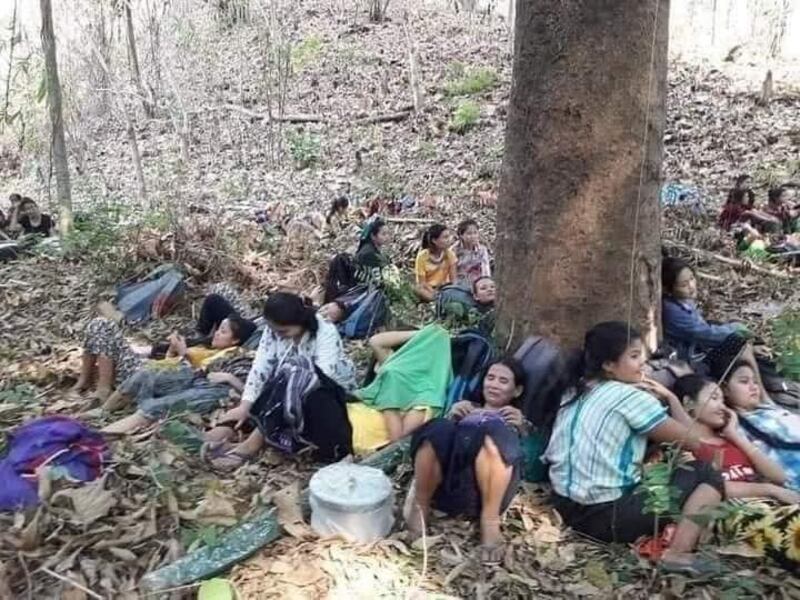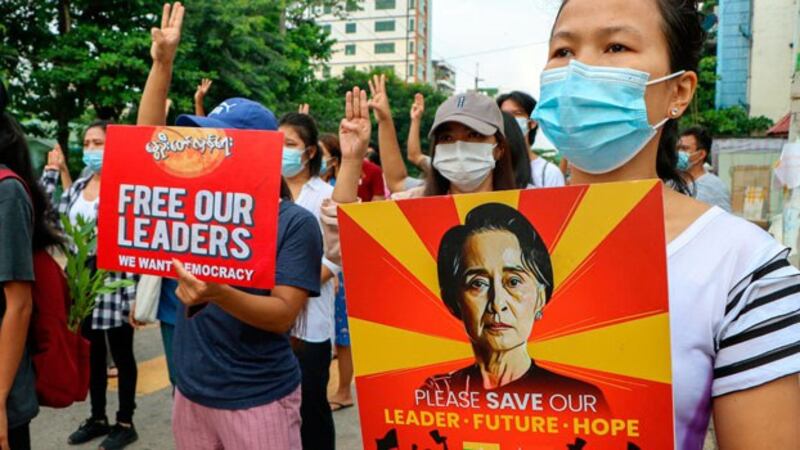Fighting in Myanmar’s Chin, Sagaing, and Shan regions has displaced thousands of new villagers since the beginning of the month, sources said Monday, as clashes between military troops, militia groups, and ethnic armies continues to intensify amid the turmoil of a junta coup in February.
A source told RFA’s Myanmar Service that nearly 6,000 residents from seven villages along the Hakha-Matupi Road in Chin state’s Hakha township have been evacuated since June 1, when soldiers hunting for members of the Chinland Defense Force (CDF) militia began threatening residents.
“Hakha is about nine miles away and the military wanted to clear the entire route in the area,” said the source, speaking on condition of anonymity for fear of reprisal.
“More than 100 troops are looking for CDF members. The villagers fled to safety before they arrived.”
A network of volunteers formed in April, the CDF are taking on Myanmar’s army—the second largest in Southeast Asia—with slingshots and the same crude flintlock “Tumee” rifles their forefathers used to fight off British colonizers in the 1880s. The CDF said it had killed some 100 junta troops between March and May.
Following the Feb. 1 coup, most Chins joined compatriots across Myanmar in daily street protests, only to be met by deadly military violence that has killed more than 850 civilians nationwide. In the three months to May 1 alone, 28 civilians in Chin state were killed and more than 200 were arrested, according to the Chin Human Rights Organization (CHRO).
The CHRO estimates that some 40,000 civilians have fled their homes in Chin state since May.
Fighters of the CDF were engaged in daily battles from May 12 until May 15, when the junta occupied the town of Mindat with 1,000 fully armed troops who used civilians as human shields and sprayed gunfire indiscriminately, the CHRO said recently. The CDF pulled out May 16 to protect civilians from further artillery attacks and fire from helicopter gunships, one Chin fighter said.
But a CDF source told RFA that over the past five days, fighting had resumed in Mindat, leaving three militiamen killed and seven others injured.
“A military jet came by and dropped four bombs and then there was artillery fired from the Kyaukhtu township area,” he said. “Motorcycles and other things left behind by the refugees were torched.”

Sagaing refugees
A clash between the military and members of the People’s Defense Force (PDF) militia in neighboring Sagaing region also took place on Sunday near Yinmabin township’s Si Hlaung village, according to residents, forcing more than 1,000 people to flee.
A member of the PDF in Si Hlaung said the military entered the village around 9:00 a.m. after shelling the area.
“Our people don’t have enough strength and had to retreat. We have no weapons to match theirs,” the PDF member said, adding that militia reinforcements arrived later, but the military had set up a strategic position in the nearby mountains that prevented a counterattack before troops left in the evening.
“The fleeing villagers are in serious trouble and are searching for places to stay where they have access to water.”
A resident of Si Hlaung said an 18-year-old PDF member was killed in Sunday’s clash and that his body had yet to be retrieved, adding that it is unclear whether the military suffered any casualties.
“The people will continue to fight no matter what—we will not give up,” said the resident, who also declined to be named.
“People dare not sleep at night, wondering when [military troops] might appear or where they might come from. We are worried they might show up in civilian clothes.”
RFA’s calls to Myanmar’s Deputy Information Minister Maj. Gen. Zaw Min Tun seeking confirmation of recent clashes went unanswered Monday.
Myanmar’s internal refugee crisis is dire and getting worse. Internally Displaced Persons in the country’s remote regions are crowded in makeshift camps that lack basic necessities, including food and water and medical supplies.
In addition to the reports from Chin state and Sagaing region, aid workers in neighboring Kayah state estimate that clashes between the military and local militias there prompted some 100,000 people to flee their homes in May alone.
In addition to clashes with the military regime, Myanmar’s myriad ethnic armies have continued to fight amongst themselves in the pursuit of new territory, further exacerbating the country’s refugee crisis.
Clashes between the Restoration Council of Shan State (RCSS) and the combined forces of the Shan State Progress Party/Shan State Army-North (SSPP/SSA-N) and Ta’ang National Liberation Army (TNLA) broke out near Manli village in northern Shan state’s Namtu township in April.
More than 3,000 residents of Namtu and nearby Hsipaw township had fled the fighting as of mid-May, but new clashes between the two sides near Kyethi township’s Mong Kaung village in southern Shan state have prompted around 1,000 additional people from five villages to seek refuge since June 1, a source told RFA.
“We have refugees at four monasteries already and as there were more clashes today near Mong Kong village, the numbers will rise,” said the source.
“They did not want to come—nobody wants to leave their home. Only the elderly and children who cannot run in an emergency, as well as the young people who could be taken away [by the military and made to work] as porters are here taking shelter.”
The source said that residents had received no assistance from civil society organizations, which have had tremendous difficulty providing aid due to the fighting.
Fighting between the RCSS and the TNLA intensified between 2015 and the end of 2017 in northern Shan state and in April 2018, the TNLA began joint operations with the SSPP/SSA-N in Namtu township. According to the SSPP/SSA-N, talks between the two Shan ethnic armies have yielded little progress.

State Counselor trial
Meanwhile, the junta plans to begin hearings against Aung San Suu Kyi for violating Myanmar’s Official Secrets Act next week, Khin Maung Zaw, the lawyer for the deposed State Counselor said Monday.
Aung San Suu Kyi, President Win Myint, and other leaders of Myanmar’s democratically elected government were arrested shortly after the military coup and have been held in pre-trial detention on various charges.
Aung San Suu Kyi, the de facto leader of the country, has been indicted by the junta in six cases and faces charges that include spreading information that could cause public unrest, violating COVID-19 restrictions under the National Disaster Management Law, illegally importing two-way radios, and the unlicensed use of radios. The most serious of the charges she faces—violating the Official Secrets Act—carries a punishment of up to 14 years in prison.
Speaking to journalists after a procedural hearing on Monday for Aung San Suu Kyi and co-defendants President Win Myint and former mayor of the capital Naypyitaw Myo Aung, Khin Maung Zaw said that government prosecutors will have until June 28 to finish their presentation in the court in Naypyitaw, where she is being tried on five charges. Aung San Suu Kyi’s lawyers will have until July 26 to present their case, he said, adding that court sessions will be held on Mondays and Tuesdays each week.
“As the cases are ‘simple cases,’ the judge agreed to complete the hearings within 180 days ... [beginning] from the day the charges were made, Feb. 16, 2021,” he said.
“Daw Aung San Suu Kyi will take the stand herself on June 23,” he added.
Min Min Soe, another member of the defense team, said that Aung San Suu Kyi is in good health, but running out of medication. He said that she had requested money for the welfare of her nine household staff members and her dog, Taichido.
Reported by RFA's Myanmar Service . Translated by Khin Maung Nyane. Written in English by Joshua Lipes.
